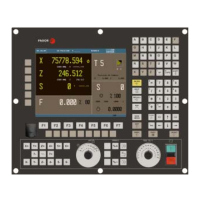·298·
Installation manual
CNC 8055
CNC 8055i
7.
CONCEPTS
SOFT: V02.2X
Axes and coordinate systems
7.1.4 Incline axis
With the angular transformation of an incline axis, it is possible to make movements along an axis
that is not perpendicular to another.
On certain machines, the axes are configured in a Cartesian way, they are not perpendicular to each
other. A typical case is the X axis of a lathe that for sturdiness reasons is not perpendicular to the
Z axis.
Programming in the Cartesian system (Z-X) requires activating an angular transformation of an
inclined plane that converts the movements of the real (non-perpendicular) axes (Z-X'). This way,
a movement programmed on the X axis is transformed into movements on the Z-X' axes; i.e. it then
moves along the Z axis and the angular X' axis.
Configuring the incline axis
The incline axis is configured by the following general machine parameters.
Configuring the axes
The parameter ANGAXNA configures the incline axis. The parameter ORTAXNA defines the axis
perpendicular to the Cartesian axis associated with the incline axis.
The parameter OFFANGAX sets the distance between machine zero and the origin that defines the
coordinate system of the incline axis. The axes defined in parameters "ANGAXNA" and
"ORTAXNA"must exist and must be linear. These axes may have associated with them Gantry axes,
coupled axes or axes synchronized by PLC.
Angle of the incline axis
The parameter ANGANTR defines the angle between the Cartesian axis and the angular axis it is
associated with. The angle is positive when the angular axis has been rotated clockwise and
negative if otherwise. If its value is 0º, there is no need to do an angular transformation.
X Cartesian axis.
X' Angular axis.
Z Orthogonal axis.
ANGAXNA X
ORTAXNA Z
ANGANTR 60º

